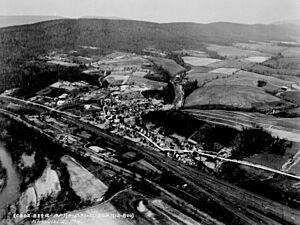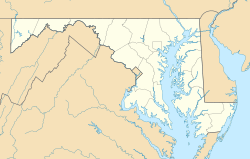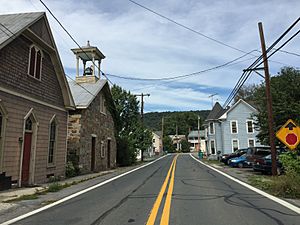Knoxville, Maryland facts for kids
Quick facts for kids
Knoxville, Maryland
|
|
|---|---|

Knoxville in April 1930
|
|
| Country | |
| State | |
| County | |
| Elevation | 86 m (282 ft) |
| GNIS feature ID | 585333 |
Knoxville is a small, quiet community in Maryland, United States. It's not a city or town with its own local government. Instead, it's an unincorporated community, meaning it's part of a larger county. Knoxville is located in both Frederick and Washington counties.
This historic area is home to some important places. The Robert Clagett Farm and Magnolia Plantation are two sites listed on the National Register of Historic Places. This means they are recognized for their special historical value.
Contents
Exploring Knoxville's Past
Knoxville is located at the bottom of South Mountain. It sits right next to the Potomac River. This river flows through a natural opening in the mountains called a water gap. This gap leads directly to Harpers Ferry, West Virginia, a very important historical town.
Early Settlers and Village Growth
The first people to settle in this area were from England and Germany. They started arriving in the late 1700s. By the early 1800s, a small village began to form. It grew along the main road that connected Frederick, to Harpers Ferry. Harpers Ferry was a key location because it had one of only two national armories (places where weapons were made) in the United States.
How Transportation Helped Knoxville Grow
In the 1840s, Knoxville really started to grow. This was thanks to new transportation routes. The Baltimore and Ohio Railroad came through, bringing trains and goods. The Chesapeake and Ohio Canal also opened nearby. Canals were like water highways for boats carrying supplies.
Another reason for growth was the industrial town of Weverton. It was built just west of Knoxville. All these new connections and industries helped Knoxville become a busy place.
A Flourishing Community in the 1800s
By 1849, a local newspaper called the Frederick Examiner reported that Knoxville was doing very well. New businesses were opening, and new houses were being built. Many of the buildings you see in Knoxville today were built in the 1840s and 1850s. These include simple, traditional homes and buildings in the Greek Revival style. This style uses design elements from ancient Greek temples.
In 1851, a German Reformed church was built on Cemetery Hill. Even though the Civil War caused some challenges, Knoxville continued to be an important transportation center. Two more churches were built in the town during these years. A Methodist Episcopal Church opened in 1869, and a Lutheran church moved to Knoxville in 1873.
The Shift to Brunswick
However, things changed for Knoxville in 1890. The Baltimore and Ohio Railroad started building a huge rail yard. This new yard was in a village called Berlin, about 2 miles (3.2 km) to the east. By 1894, Berlin became an official town called Brunswick.
When Brunswick grew, all the major industry and transportation activities moved there. This meant that Knoxville became a quieter community, as its role as a busy hub shifted to its new neighbor.




